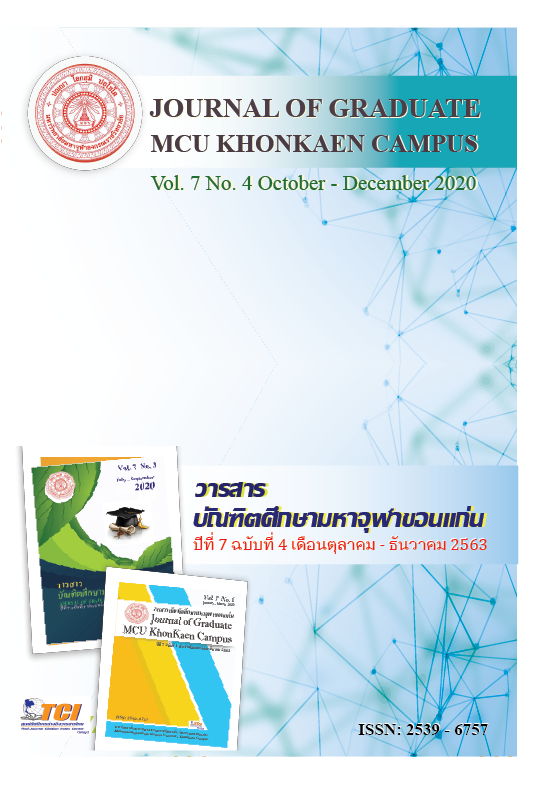BEST PRACTICE IN THAI LANGUAGE LEARNING MANAGEMENT : A CASE STUDY OF MEESOOK SCHOOL
Main Article Content
Abstract
This research have The objectives to study were 1. the best practice, 2. the factors that affected the educational success, and 3. the attitude of students towards the best practice for learning management in Thai language at primary level. The target groups were school director, Thai language teachers, students, and parents of primary school students. The research instruments were video camera, observation form, interview form, audio recorder, camera, and questionnaires for measuring attitude. Data were collected by recording a learning management video of teachers, interviewing the school director, teachers, and parents of students. The information obtained from the attitude measurements of the students was also be used. The qualitative data obtained from the protocol and data from interviews were analyzed by applying descriptive analysis. Furthermore, the quantitative data obtained from the attitude measurements of the students was analyzed by applying descriptive statistics.
The results of the research showed that: 1. the best practice had 6 steps as follows: 1) designing learning management plan. 2) Preparation of teaching process. 3) The teaching process. 4) Assessment of learning. 5) Promoting learning. 6) Educational development. 2. Factors that affected the educational success were as follows: 1) administration and regularity of the school director, 2) strictness to the roles and duties of teachers, 3) learning media, 4) learning support, and 5) parents of students. 3. The attitude of students towards found that had good attitudes towards learning management of Thai language at primary level in all aspects with a mean () as 3.99 and standard deviation (S.D.) as 0.68.
Keywords : The best practice , Learning management in Thai language
Article Details
References
เฉลิมลาภ ทองอาจ. (2561). การจัดการเรียนรู้ภาษาไทยโดยใช้สมรรถนะในศตวรรษที่ 21 เป็นฐาน : ทฤษฎีสู่การปฏิบัติ. วารสารครุศาสตร์ จุฬาลงกรณ์มหาวิทยาลัย, 46(1), 171–184.
ธีรภัทร คำทิ้ง. (2562). กระบวนการจัดการศึกษาวิชาภาษาไทยของโรงเรียนดีเด่นด้านการจัดการศึกษาทางไกลผ่านดาวเทียม ระดับชั้นประถมศึกษา. วิทยานิพนธ์ศึกษาศาสตรมหาบัณฑิต. มหาวิทยาลัยขอนแก่น.
บุญดี บุญญากิจ และคณะ. (2547). การจัดการความร้ ทฤษฎีสู่ การปฏิบัติ. กรุงเทพมหานคร : จิรวัฒน์ เอ็กเพรส.
รัชดา ลาภใหญ่. (2559). แนวทางและข้อควรปฏิบัติในการสอนภาษาไทยในฐานะภาษาต่างประเทศให้แก่นักศึกษาจีนอย่างมีประสิทธิผล. วรสารมนุษยศาสตร์และสังคมศาสตร์, 12(21), 42-43.
วุฒิพงษ์ คำเนตร. (2558). วิธีวิทยาการการจัดการเรียนรู้ภาษาไทยโดยใช้บันได 5 ขั้น ของการพัฒนาผู้เรียนสู่มาตรฐานสากลในศตวรรษที่ 21 (Five Steps for Student Development). สืบค้นเมื่อ 9 กันยายน 2562, จาก http://wutthiphong
khamnet.blogspot.com/2015/06/five-steps-for-student.development.html.
สนิท ฉิมเล็ก. (2540). พฤติกรรมการสอนภาษาไทยระดับประถมศึกษา. พิษณุโลก : สถาบันราชภัฏพิบูลสงคราม.
สุวิทย์ มูลคำ และอรทัย มูลคำ. (2554). 19 วิธีการจัดการเรียนรู้ : เพื่อพัฒนาความรู้และทักษะ. กรุงเทพมหานคร : โรงพิมพ์ภาพพิมพ์.
อัจฉรา ชีวพันธ์. (2531). ศาสตร์ของการสอนภาษาไทย. กรุงเทพมหานคร : คณะครุ ศาสตร์ : จุฬาลงกรณ์มหาวิทยาลัย.
อัจฉรา ชีวพันธ์. (2547). ภาษาพาสอน : เรื่องน่ารู้สำหรับครูภาษาไทย. กรุงเทพมหานคร : บริษัท แอคทีฟ พริ้น จำกัด.
อัจนา มุกดาสนิท. (2545). เจตคติต่อคอมพิวเตอร์ของพนักงานธนาคารกรุงเทพ จำกัด (มหาชน) สาขาในเขตจังหวัดชลบุรี. วิทยานิพนธ์ศึกษาศาสตรมหาบัณฑิต : มหาวิทยาลัยบูรพา.

